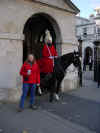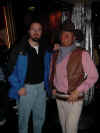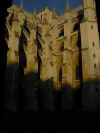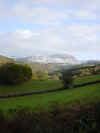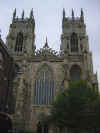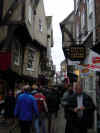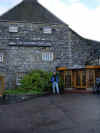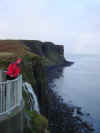| The Lustik Travel Home Page |
November 1 - 15, 2001
Thursday, November 1, 2001 London,
England
We spent the morning keeping an eye on my sick nephew, Alexander. We hopped on the tube and went into town around 1:00. We mostly just walked around. We passed by the Horse Guards on our way up to Trafalgar Square, which is the geographic center of London. A statue of Lord Admiral Nelson sits atop a tall column in the square, commemorating his role in the victory at the Battle of Trafalgar. Now Trafalgar Square is popular because of the large pigeon population awaiting handouts.
We walked through St. James Park on our way to Buckingham Palace, the queen’s residence. We did not make the effort to be there for the changing of the guard. We then took a long meandering walk that took us along the River Thames and back up to Trafalgar Square. We walked through St. Martin-in-the-Fields Church and listened to some musicians warming up for a concert tonight. This small church has excellent acoustics for concert performances and is often used for classical music recordings. We zigzagged through the colorful Soho area on our way back to the tube stop.
1) Horse guard; 2 and 3) Buckingham Palace. 4) How bored these Palace guards must be!
Friday, November 2, 2001 London, England
We were blessed with our third straight day of great weather. We went into town and made our first stop at Madame Tussaud’s Wax Museum. We were very glad to have pre-purchased our admission tickets on Wednesday, putting us in the front of a very long line awaiting entry to the museum. Madame Tussaud got her start by making death masks of guillotine victims during the French Revolution. The exhibits were very good, and we found our visit there pleasantly worthwhile.
We jumped back on the tube and made our way over to St. Paul’s Cathedral, a London landmark. Designed by Sir Christopher Wren, it was completed in 1710 after 35 years of construction. The approved design of the Cathedral had a steeple instead of the dome we saw today. Wren circumvented resistance to his desire to build a dome by exercising a minor clause in his construction contract to make necessary changes “as he saw fit” during the building phase. Wren successfully enveloped the construction site with scaffolding and only passed out work assignments a day in advance. In this manner the dome was nearly completed before anyone was the wiser. St. Paul’s Cathedral now boasts the world’s third largest dome.
Christine and I took a self-guided tour of the Cathedral, which included climbing 627 winding and steep steps to the top of the dome. The views of the London skyline were worth the climb, though my legs nearly cramped up on the descent. During WWII a group of men were stationed in the Cathedral and stood watch on the dome to protect the cathedral from Germany’s firebombs. The cathedral withstood some direct hits and benefited from the firefighters on hand. Londoners view the survival of St. Paul’s Cathedral as a national triumph. The basement level of the cathedral is a mammoth crypt with the tombs of many national heroes, and Wren himself.
We fed our hungry bodies and then took the tube over to Notting Hill to walk through the Portobello Street Market. This is the market that is seen in the movie, Notting Hill with Julia Roberts and Hugh Grant. The market was pretty busy, but nothing like the crowds that come on the weekend. We finally headed back to the house and rested up for tonight’s planned activities.
Maria had arranged for her nanny to come baby-sit Alexander and Zachary so that we could all go out for dinner and the theatre. This was a birthday present for Benjamin, so his girlfriend, Lisa was included to round out our party of six. We took the tube down to the West End theatre district and walked to our dinner at Cub de Asia, a very trendy restaurant that pleased us with interesting dishes that were served as tapas, allowing us all to sample the flavors.
After dinner we walked up to the Cambridge Theatre to see the musical, “Fame.” Maria and I were both a bit surprised and disappointed that all new music was written for the stage production. Only the title theme was reused from the original movie score. The show was still excellent with a great new slate of songs.
1) Joe and The Duke. John Wayne was just one of the many wax figures at Madame Tussaud's wax museum. 2) One doesn't have to go to Rome to see the Pope. 3) Starting down from the top of the stairs at St. Paul's Cathedral. 4) The view of London from the top of St. Paul.
Saturday, November 3, 2001 London, England
We drove down to Regent’s Park with Maria and Alexander to join Scott in watching Zachary’s soccer game already underway. Maria, Christine and I had a lovely breakfast at a park café. Maria left us to watch Alexander’s game while Christine and I walked around Regent’s Park. The Inner Circle gardens still had plenty of roses in bloom, though they were clearly on their way out.
We returned home for a relaxing afternoon before heading back out again for the annual celebration of Guy Fawkes Day. Officially observed on November 5th, the biggest festivities were scheduled for tonight, being a weekend. Guy Fawkes was a radical Catholic that very nearly succeeded in blowing up Parliament in 1605. This event has been remembered annually with fireworks and bonfires. We were invited to join my sister’s family at a party hosted by the parent of one of Zachary’s school pals. Their residence is on Primrose Hill, optimal location for observing the fireworks. We all filed out onto the hill around 7:30 with 100,000 other revelers to watch one of the finest fireworks displays that I have ever seen. The event got cancelled last year because of the rain, and apparently the unused funds from last year helped pay for a doubly big show this year. After thirty continuous minutes of explosions we filed back to the party and enjoyed the company of other Americans while we waited for the traffic to die down.
Just one of the many groups of roses in Regents Park.
Sunday, November 4, 2001
London, England
We really lazed around today, especially me. After lunch we all got together and climbed into the mini-van to attend a school concert in which Benjamin was scheduled to perform. We dropped Benjamin off early at the school for a pre-concert rehearsal. We then drove over to Camden Market to kill some time. We passed by the location that was photographed for the album cover of the Beatle’s Abbey Road. Camden Market is a massive sprawling assortment of booths selling ethnic foods, antiques, furniture, and primarily trendy clothes and accessories. One goes there more for the people watching than for the shopping. We were careful not to lose track of my two small nephews as we sampled the eccentric atmosphere.
The school concert was very good. Benjamin performed a concerto grosso by Vivaldi with another violinist and a cellist. Other performances included jazz combos, woodwinds, and vocalists. We all really enjoyed the event.
By Christine: I would just like to comment on the concert this afternoon. There are some very talented musicians in Benjamin’s school. This was a concert where any musician or singer was welcome to perform solo or in groups. The purpose is to give those that desire the practice and confidence performing in front of groups. Some of the individuals even performed music that they had written. It was very impressive.
Our oldest nephew, Benjamin, and his partner during the concert.
Monday, November 5, 2001
London, England
Christine and I left the house before noon and went across town to look at a motorcycle that I have been eager to see. The Yamaha FJR1300 is a new bike that has not yet been released in the U.S., and may become my next motorcycle. I found a dealer that had one in the showroom, and was pleased to show it to me. Christine tagged along willingly and shared in my excitement at how well I fit on it. At ₤10,000 (nearly $15,000 US) I am willing to wait until Yamaha finally releases the bike in the states, and save several thousand dollars.
We finally got in a tour of Westminster Abbey today. The tour is mainly a “who’s who” of English history due to the 3000 tombs enclosed in the structure. The remains of 29 kings and queens are entombed there along with many other royals, poets, warriors and clergy. The abbey is also where almost all coronations are held. It had been a Catholic place of worship until the Reformation movement in the 16th century, and has been part of the English Church since then. We rented an audio tour that gave brief accounts of many of the tombs—too many to absorb.
We walked back up to Trafalgar Square and ate a late lunch before exploring the National Gallery of Art. We got through all of the East Wing and much of the North Wing before being kicked out at closing. The assortment of works by the Impressionists was the most enjoyable for me. There were only a few Van Gogh works, but many from Monet and Seurat.
Christine and I hopped back on the tube to meet Maria and Scott near the East End of London for dinner and a house tour. We chose an Indian restaurant amongst many on Brick Lane in Bengal Town. We had an excellent dinner of assorted Indian cuisine and then walked to Dennis Sever’s House. This is a unique house-tour experience. An imaginary 18th-century family resides in the house, and it appears that they have just left each of the rooms in the house as we entered them. The experience requires the tourists to place themselves into the scene so as to imagine life in that time. Our candlelight tour was aided by the absence of electric lights. The tour requires complete silence so that all the senses can aid the imagination. Dim soundtracks of horses on cobblestones, church bells, and period conversations contribute to the illusion. The smell and display of fresh foods emphasizes that the house is currently occupied. Warm coal fires are burning in all the fireplaces. We spent enough time in each room to try to identify who the occupants might have been, and what might have called them away. This unique tour challenged my ability to suppress modern comparison, but I think I got it pretty well. For some, the experience is overwhelming and emotional, but we all fell short of that response.
1) The Yamaha FJR 1300 and a dreaming Joe, when will it come to the US is the question? 2) The front of Westminster Abbey. 3) The inside of the abbey looking through a courtyard in the monestary.
Tuesday, November 6, 2001 London, England
Today was a walking day. We took the tube into town and then walked through Hyde Park and Kensington Gardens on our way to see Kensington Palace. We passed on the expensive admission to tour the inside of the palace. We ate lunch in the gardens and then walked up Embassy Row, a spectacular half-mile of manors along Kensington Palace Gardens. We walked back through Hyde Park before returning to the house to begin preparations for our drive around the country, which begins tomorrow.
After a quick dinner I went out with Maria and Scott to hear a lecture being given at Benjamin’s school by Terry Waite. Terry Waite is the well-known former assistant to the Archbishop of Canterbury that has spent the last twenty years involved with seeking the release of hostages held around the world. Terry Waite reached widest notoriety when he was taken hostage himself while trying to get the release of American, Terry Anderson from Iran. He was held for five years, four of which had him in solitary confinement.
Terry Waite is a fascinating man that achieved an apparent full recovery from his confinement. He spoke initially about the fundamentals of negotiating for hostage release, and then he spoke in detail about the circumstances of his own detention. During a question period following his lecture he volunteered some very personal opinions about the current state of affairs between the East and the West relating to the terrorist acts of September 11th. I won’t go into detail, but Terry clearly prefers achieving results through non-violence. I felt very fortunate to attend his speech.
By Christine: I will take this time to put a few of my thoughts down. I love how much we walk every day. I enjoy the ease of the tube as a form of transportation. It is quite easy and convenient and so much easier than driving in London. Joe made a comment today about passing on going into Kensington Palace. You will find that we often don’t feel the need to pay the admission prices. One could easily spend a lot of money on the sites, every day. In reality do we need to go in every church, palace, and castle? Luckily, no.
1) Kensington Palace, the home of many royalty and past home of Princess Diana. 2) This is Hyde Park. The parks in London are huge and beautiful.
Wednesday, November 7, 2001 Bath, England
We left London this morning just before 10:00 without incident. We were smart to wait until after rush hour before first trying right-side driving on the left side of the street. My only other experience with this reversal of driving rules was during our honeymoon in St. Lucia. It hardly compares since there was so little traffic on the island.
We made our way southwest of London to pay a visit to Stonehenge, the fairly notorious rock formation. At 5000 years old, it is the most significant historical site. The labor involved in quarrying, transporting, and carving these stones is astonishing, all the more so when you realize that it was accomplished before the major pyramids of Egypt were built. Current beliefs are that the builders may have been Greek from Mycenae, reinforced by the likely astronomical nature to its purpose. The stones are aligned with respect to astronomical references.
We did not dally long at Stonehenge since I am more interested in its history than the actual stones. The formation is substantially incomplete now. For the past millennia the druid religious order has incorporated Stonehenge into its worship practices, though the druids had nothing to do with the creation of Stonehenge.
We continued on and arrived in Bath early in the afternoon. We checked into a very nice B&B before setting out to explore the town on foot. Bath has quite a bit of its own history, and it is a popular site as the town where author, Jane Austen lived for a time. Two of her books are specifically set in Bath. We walked across the Great Pulteney Street Bridge, uniquely lined with shops, and we walked through the parade ground gardens overlooking the Avon River. They were still splendid with the blossoms of hearty flowers. We continued past the Bath Abbey and the Roman Bathhouse (town’s namesake). We were impressed with the ballrooms and the reception hall in the restored Assembly Rooms building. The Circus (circle of brownstones) and the Royal Crescent (grand semi-circle of 18th century townhouses) were quite impressive. We squeezed in a tour of the Jane Austen Centre to learn more about this remarkable author.
We paused over a pint of ale in a pub to consider our dinner options. We later stumbled across the Pulteney Arms Inn for a fine pub dinner of fish and chips with some fine pints of Grolsch served cask-conditioned (un-carbonated). We really enjoyed the evening and noted our pleasure of being on the road again exploring new areas. The weather today had been fairly cooperative with infrequent showers occurring only while we drove.
1) Stonehenge. 2) This is a picture of Stonehenge, taken from a postcard. 3) The Great Pulteney Street Bridge in Bath, all lined with shops. 4) This picture shows some of the Parade ground gardens in Bath.
Thursday, November 8, 2001 Dolgellau, Wales
We were served an excellent breakfast and got out of Bath shortly after 9:00. We drove northwest into Wales and took a scenic route along the Wye river on our way to Brecon Beacons National Park. This National Park is unlike those in the U.S. that restrict private development. These lands had been occupied long before they government turned them into a park. The park designation acts to preserve the status quo by inhibiting future development. The mountains, uplands and moors made up some spectacular scenery, most of it too challenging to photograph. We settled for drinking in the scenes as we could.
We pushed further west along twisty roads to the coast of Cardigan Bay. The wind was whipping the sea into a frenzy, and the occasional drizzle cycled through hail, sleat and snow. We reached Dolgellau at the southern end of Snowdonia National Park and found a nice B&B for the night. We then headed out on foot in search of dinner. Dolgellau is a very dense little town with 3-4 story buildings lining very narrow streets.
We stumbled onto a pub called The Unicorn and settled in for some good beers and meals of fish and chips. I was hoping to find a place that would serve up some Welsh lamb, but our pub meal turned out very well for us. We met an American Army officer traveling on his own in search of his family roots here in Wales. He is stationed in Germany, and found common ground with us talking about motorcycles and skiing.
Something must be said about the chips (french fries) served here. They are served with nearly all meals, even if not specified. They are comparable to steak fries in the U.S., only better. The consistency of crispiness on the outside and tenderness in the middle make them a delight on their own. I’ve even stopped adding ketchup to them. I don’t know why french fries taste so much better here—they just do. Maybe it has something to do with calling them chips instead of fries.
These are both pictures of the Wales countryside. We didn't take many pictures of countryside as it was often gray and not good for taking pictures.
Friday, November 9, 2001 Manchester, England
We awoke to a cold morning with clearing skies. The precipitation from yesterday had left snow across the hills and mountains. It made for a beautiful morning drive after our scrumptious breakfast. We drove northwest through Snowdonia National Park until we reached the castle city of Caernarfon on the Menai Straight. Caernarfon was one of seven castles erected under the direction of King Edward I late in the 13th century in a move to finally subdue the Welsh. His “ring of castles” around North Wales was established so that each castle was within a day’s march of the next. These castles mark some of the finest from medieval times. Caernarfon was the grandest of the ring and stands today in excellent preservation. To complete his domination over the Welsh, Edward I promised to designate a ruler that would speak no word of English. He accomplished this by sending his pregnant queen to Caernarfon to deliver his first-born son. Triumphantly, Edward I presented the infant to the assembled chieftains as their prince “who spoke no English, had been born on Welsh soil, and whose first words would be spoken in Welsh.” The ruse worked, and on that historic day was created the first prince of Wales of English lineage. The tradition still holds: in 1969, Queen Elizabeth II presented Prince Charles to the people of Wales as their prince from this castle. We enjoyed exploring the nearly empty castle on our own. We climbed several of the towers and watch a film about how Edward I subdued the Welsh.
We left Caernarfon and headed northeast to Conwy for a tour of another castle from Edward’s ring. Conwy is smaller, but still very much in tact. We benefited greatly from a de facto private tour from a very old gent that had oodles of information to impart upon us. Having just come from Caernarfon the guided commentary was even more relative. All the “ring” castles are attached to a city wall that held the homes of English subjects within its defenses. The castle’s primary defense was its barbicon, a chambered entryway that would trap hostile intruders in a merciless painful death. The castles’ construction was specific to the anticipated annual visit by the king. Many of the castles’ halls and towers were left unused for most of the year.
I learned any interesting piece of trivia that I’ll share here. Medieval hygiene was very poor, and clothes were rarely cleaned. Clothing tended to become infested with lice and fleas, and other bugs. A common way to rid the clothing of bugs was to hang the clothes in the room with the toilet. There was no plumbing at the time, so the toilets were consistently foul smelling. Ironically, this seemed to be an effective way to disinfect their clothing. Their name for the rooms that had the toilet was “garderobe.” The word can be taken apart to mean (garder: kept in) and (robe: clothing). Many European languages still have a derivative of this word in their vocabulary. In English, we know this word today as “wardrobe.” In this respect it loses its association with the toilet. The closest accurate use to the original would be the European reference to W.C. today for the toilet. W.C. stands for Water Closet. Closet is a derivative from the word meaning: clothes. I found this all quite interesting.
Upon leaving the beautiful castle in Conwy, Christine and I tried to reserve a room for our planned visit to Edinburgh tomorrow and Sunday. We learned that a rugby match there tomorrow had filled all the rooms. We went ahead and found a room for Sunday night, and then we worked on making new plans for Saturday. We decided to visit the city of York in Yorkshire with the extra day. We had originally planned to stop here on our way back from Scotland. We got just outside of Manchester before stopping in a Travelodge for the night. We found another nice pub we could walk to and had a great dinner. I order the lamb chops, since I missed them in Wales. They were excellent, and full of flavor—only lightly minted.
By Christine: It seems to me that there is a pub anywhere in this country within walking distance! Always a good thing. The one thing about the pubs is how smoky they are inside. That is defiantly something we are not as used to in the states with so many restaurants smoke free or providing very large non-smoking areas. It defiantly seems that more people smoke in England than in the states.
1) This was taken from one end of the Caernarfon castle looking through the inside to the other end of the castle. 2) This is the inside of the Conwy Castle. 3) A view of some of the Snowdonia mountains. To see more of these beautiful castles and others, check out the new Spotlight Pictures page.
Saturday, November 10, 2001 Ancrum, Scotland
We arrived in York late in the morning and found the town very busy. It was a cool gray day, but being Saturday probably contributed to the crowds. We toured York Minster cathedral, the largest gothic church in England. It is a massive structure in excellent condition. We left the cathedral and enjoyed some pizza for lunch, for a change of pace. We then walked along the top of the protective wall that lines the original confines of the city.
We spent the rest of our visit muscling through the crowds that filled the shop-lined streets. We stopped near the well-preserved Shambles area to watch a very entertaining escape artist free himself from being strapped into a straightjacket and then bound by a chain. He was a real crowd pleaser. After doing a little shopping we decided to move on.
We continued north along the secondary roads leading to Scotland. The sun peaked through the clouds occasionally, but it mostly stayed fairly dark. We began to see snow as we moved farther north. Scotland had received a few inches of snow two days ago as we were skirting the weather in Wales. There was little left of the snow that fell. Darkness overtook us as we crossed into Scotland. It’s pretty dark this far north by 4:30 in the afternoon. I think we are at a latitude comparable to Edmonton, Alberta.
We found a B&B we had called from the guide that Maria had loaned us. It is just a couple miles outside of Ancrum down some single-track (one lane) roads. We checked into our room and sat down in the parlor for a civilized cup of tea in front of a warming fire. This gave us an opportunity to consider our dinner options. We elected to return to a pub in Ancrum for dinner at the Cross Key Inn. We enjoyed yet another excellent pub meal. These meals of meat, potatoes and vegetables emanate a sense of comfort and well being…washed down by a couple pints of cask conditioned ale leaves little room for improvement.
I feel the need to take this opportunity to speak about the beer here. There is certainly every opportunity to get beer here as that to which most Americans are accustomed. We have even seen Budweiser on tap. A closer experience to English beers is now available in the U.S. Some microbreweries are offering an occasional beer “cask-conditioned” from the tap. This is the traditional manner in which beers are served in England. Americans are used to a substantial amount of carbonation being added to the beer as it is drawn from the tap. Cask-conditioned beers receive a genuine head of foam as they are hand-pumped from the keg into a glass. The resulting beer is served “flat” by American standards. The other significant difference is in temperature. A draft beer in England is served at a much warmer temperature (50-55 degrees F) than Americans are accustomed to. So how could anyone get excited about a warm flat beer?
I don’t know that I can properly answer that question, other than to say that I had always been suspicious about the appeal of these beers. I am now living it, and am thoroughly enjoying. The lack of carbonation is a relief. I never feel belchy or bloated from these beers; and being warm means that I can take my time enjoying the beer, not fearing that it will reach an unsatisfying warmth. Above all, the beers taste great. I am truly loving this part of the experience.
Christine threw the pub bartender for a loop tonight when she asked whether he had any whiskeys that weren’t a scotch. The bartender really struggled with the concept. It might be like going to McDonalds and asking for a hamburger that wasn’t made from beef. We finally got him to switch gears and he spoke a word that we identified as “bourbon” by a process of elimination. We came full circle to learn that he had Canadian Club and limonade, so that Christine could get the C.C. and 7 that she desired.
By Christine: After we returned from dinner this evening, our hosts invited us in to the family room to chat with them and a couple of their friends that were visiting for the evening. Joe went up and caught up on the log, but I took them up on the offer. They had a wonderful fire going and we had a lovely time chatting about the sites to see in Scotland; the abundance of the deer population here and what a nuisance they are; where some of the better woolen mills are; and about the current world circumstances. I find that the people here are very welcoming, friendly and they seem to have a lovely sense of humor. The host even poured some of the local single malt scotch all around. Although I’m not really a scotch drinker, once it was diluted with some water it wasn’t bad. This description in itself is probably a sin to Scotch drinkers as it is my understanding it was a very fine scotch.
1) York Minster. 2) The York street artist. 3) This is a street called the Shambles. The houses are so close together the residents can touch reaching out their windows. The first floors of all these buildings are now shops. 4) The B&B that we stayed at outside Ancrum. The view from our window was amazing.
Sunday, November 11, 2001 Edinburgh, Scotland
We woke to a lovely day and a great breakfast. The views from our B&B across the valley to the rising sun were remarkable. We took a side trip this morning to the woolery area of Hawick. Unfortunately, there was very little going on there at 10:00 AM on a Sunday morning in November. We agreed that we could stop here again on our way back south next week.
Christine announced that she’d picked up a cold. The Jenson household seemed to be fighting the beginnings of colds when we left London. We had both been slamming vitamin C to prevent this occurrence, but Christine fell victim. We drove on into Edinburgh and checked into our B&B shortly after noon. We were pleased that it was ready for us. We settled in so that Christine could get a rest. I was feeling a bit unambitious myself. We located an Internet café so that Christine could do some schoolwork. I dropped her off and took in a matinee movie. Later we ventured out on foot in search of dinner. There were quite a few searches near our B&B in the New Town area. We settled on some tasty pies and beer at the Barony pub.
Monday, November 12, 2001 Coupar Angus, Scotland
We awoke to a heavy rain, and Christine’s cold was full on. We scratched our plans of exploring more on foot, to Christine’s relief. We drove around to see Edinborough’s primary landmarks. We made a couple passes along the Royal Mile, the historic cobbled avenue that connects the royal palace at one end with the castle at the other. Our diminished tourist desires kept us from venturing much from the car.
We made our way north out of Edinburgh across the Firth of Forth (a firth is a Scottish inlet). We got a great view of the famous railroad bridge that crosses the firth. It’s trusses are symmetrical both horizontally and vertically, and it was design to appear Victorian in style.
We then drove along the Fife Coastal Scenic Route up to St. Andrews, the origin of golf. I left Christine napping in the car as I explored the area. I was disappointed to find the British Museum of Golf was closed for renovation. It is supposed to have a great exhibit about the birth and evolution of the game. The Royal & Ancient Clubhouse was surrounded in scaffolding, but the reverence of the place could still be felt. These are hallowed grounds for golf enthusiasts. I felt like I was at Graceland, so to speak.
We continued north across the Firth of Tay into Dundee. We stopped for lunch and had a look at the polar exploring ship, Discovery, which Captain Robert Scott used to explore Antarctica. It was built here in Dundee a hundred years ago, and rests here now on permanent display. We drove toward the central highlands of Perthshire and found a quaint hotel for the night. It is the first place that we have found that we could connect Christine’s laptop and check e-mail. Christine caught up on some school work and then went straight to bed.
1) The Edinburgh Castle. This would have been a good castle to tour if I had been up to it. The castle can be seen from many places in the city and kind of presides over the city. 2) This is the railroad bridge over Firth of Forth. Joe really liked this bridge. 3) For the golf lovers among us, this is a picture taken from a postcard of the Royal and Ancient Clubhouse.
Tuesday, November 13, 2001 Inverness, Scotland
Christine was still suffering miserably from her cold today, so we got a pretty slow start. When we finally hit the road we were greeted with sunshine and beautiful scenery. We crossed over and through the Grampian Mountains as we meandered across the highlands. We passed some ski areas that were already speckled with snow. The driving was very slow on narrow and twisting roads, but I was loving it. We stopped at Dufftown in the middle of Whisky Country to visit the Glenfiddich Distillery. Glenfiddich (glen: valley, fiddich: of the deer) was established by William Grant in 1870 distilling single-malt scotch, and is still operated by the family now five generations later. There are so many well-known distilleries in the area; we chose Glenfiddich because of its highly regarded tour.
It is said around the whisky (proper Scottish spelling has no ‘e’) area that: “Rome was built on seven hills, and Dufftown was built on seven stills.” Glenfiddich is the only distiller in the area that both makes and bottles its whisky on the original property. I was amused to learn that the whisky sold in the gift shop on the premises has to travel 400 miles to get there. All whisky distilled in the UK has to go through a central distribution center to be taxed before it can be sold.
What makes this such a fine whisky area? Different distillers brag about the quality of the local spring water they use. More likely though, there is a substantial supply of peat here that is burned to infuse a specific flavor into the malt during roasting. There are so many scotches to choose from here, and they are all reputed to be distinct. It is ironically unfortunate that neither Christine nor I care for the taste of scotch. We did however; enjoy learning about the history of scotch whisky.
We moved on after lunch to Inverness, the capital of The Highlands. We found a very nice B&B atop a hill overlooking the Inverness Castle and the River Ness. Christine succumbed to her cold and stayed in bed while I went out for dinner. I found a nice pub and enjoyed a fixed-price meal accompanied by the newspaper. I brought back some carryout (the English call it “take-away”) Chinese Food for Christine.
By Christine: Today’s drive was lovely, what I could stay awake for anyway. My cold drugs had me falling asleep despite the curvy roads, very unlike me.
1) The Glenfiddich malt barns. 2) The stills at the Glenfiddich distillery. 3) The Glenlivet distillery and it's beautiful scenery.
Wednesday, November 14, 2001 Sligachan, Scotland
We drove south along Loch Ness, a very long and deep lake left be a glacier. We stopped in Drumnadrochit to experience the comprehensive exhibit there about the Loch Ness Monster. I was surprised to learn that the history of modern sightings dates back to the 1870’s. The exhibit took a very objective look at the known facts about the myth. Over 1000 reputable eyewitness sightings have led to millions of dollars worth of scientific research exploring all the known possibilities. In the end, the lack of conclusive proof to the existence of the being has resulted in an effort to explain all the sightings. The exhibit does a good job of offering up possible explanations for specific sightings. My opinion overall is that the many sightings are a strong example of the power of suggestion. A strange shadow from a wave on any other body of water is just that—a strange shadow; on Loch Ness, it becomes a possible sighting.
We turned west toward the Isle of Skye and passed through some extraordinary scenery. The minimalist appearance of the environs was similar to tundra or high alpine terrain, but much more moderate. We surprised ourselves by finding the Eilean Donan Castle. This castle has been beautifully rebuilt in its original location by the descendents of the family that acted as constable (caretaker) over 500 years ago, the clan MacCrae. The original castle was all but obliterated by the English during the Jacobite uprising in the 1700’s. The rebuilding was accomplished between 1912 and 1932, and was a summer residence for the MacCraes until it was opened to visitors in the 1950’s. The tour of the insides offered a little insight into castle life, but the exterior conjures up romantic medieval fantasies. The castle is prominent in the film “Highlander” and has a small roll in the James Bond film: “The World is not Enough.”
We crossed onto the Isle of Skye (translates appropriately into “Island of Mist”) and began our search for a place to stay. We happily ended up at the quaint Sligachan Hotel just below the Cuillin Hills towering over the center of the island. We chose it for its attached brewery, which we found to be closed for the off-season. The hotel pub proved to be very warm and satisfying. We took our dinner there over a couple games of cribbage in front of a cozy fire.
1) The Loch Ness, without a monster in site. 2 and 3) These are both views of the Isle of Skye countryside. Number 3 is at low tide.
Thursday, November 15, 2001 Sligachan, Scotland
Christine awoke me this morning in a much-improved condition. Her cold had finally broken. The worst of it only lasted for about two and half days. She really did well considering all the travel we accomplished in the past few days.
The Isle of Skye lived up to its name by meting out an intermittent mist all through the day. The occasional breakthrough of sunshine resulted in large rainbows overhead. We set out on completing the loop road around the island. The low ceiling of clouds darkened our views and hid the full drama of the terrain, yet we both were thoroughly impressed with the scenic beauty through which we passed.
We stopped to visit the inhabited Dunvegan Castle, but opted not to take the expensive tour. It too, was a splendid castle in appearance. We then found a very productive potter that was still open for business. We cruised on around to the ferry port of Uig and stopped for lunch. We made the turn around the top of the island and stopped to photograph a nearby highland cow. These hairy horned cows have a very unique appearance. Their bangs are so long that the hair covers their eyes. We have seen them throughout Scotland and have come to enjoy seeing them when they are near the road.
I haven’t mentioned the sheep yet, so here is my observation. Throughout rural England, Wales and Scotland, there are sheep everywhere. They vary in appearance between a few breeds. Christine joked that if the sheep could organize, they would easily overthrow the humans in the UK. The sheep were usually well-contained within stonewalled fields that were hundreds of years old. The grazing areas for the sheep on the Isle of Skye were not so well defined. We drove in a constant readiness for sheep on the road. As we made our way back down the east side of the island we got caught behind a small farm truck herding a hundred sheep along the road. It seemed like a common occurrence here.
We stopped for a beer in Portree, the largest town on the island. A wet walk around the shopped lined streets left us looking forward to our cozy hotel. We returned to our room in the same hotel from last night. We had both enjoyed our lazy tour of the island. We had another fine meal in the hotel pub to cap off the day. I had an excellent dish of venison, and Christine selected the macaroni and cheese (one can’t be adventurous with every meal). By Christine: In my defense, the macaroni and cheese was very comforting after a rainy day and getting over a cold!
Coincidentally, we ended up getting to watch the James Bond movie: “The World is not Enough” on TV tonight, which showed the Eilean Donan Castle we had just visited two days ago.
1) This is one of the funny Highland Bulls. 2) Behind me is a rock called Kilt Rock, because of the creases in it and a waterfall. 3) The colorful waterfront at Portree.
Continue onto November 16, 2001...
